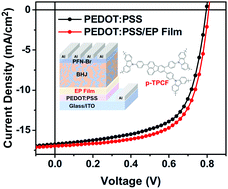Built-in voltage enhanced by in situ electrochemical polymerized undoped conjugated hole-transporting modifiers in organic solar cells†
Abstract
Herein, a new electropolymerized (EP) film named poly-triphenylcarbazole fluoranthene (p-TPCF) has been in situ synthesized by an electrochemical cyclic voltammetry method and applied to tune the work-function (WF) of the PEDOT:PSS hole-transporting layer (HTL) in organic solar cells (OSCs). Multiple techniques, including Kelvin probe force microscopy (KPFM), light intensity dependent solar cell characterization, Mott–Schottky analysis, and transient photovoltage (TPV) and transient photocurrent (TPC) measurements, have been explored to provide insights into the mechanism. Benefiting from the deeper work-function (WF), larger built-in voltage (Vbi), decreased recombination, and longer carrier lifetime, the devices with EP films exhibited superior device performance with simultaneously enhanced Voc, Jsc and FF.



 Please wait while we load your content...
Please wait while we load your content...